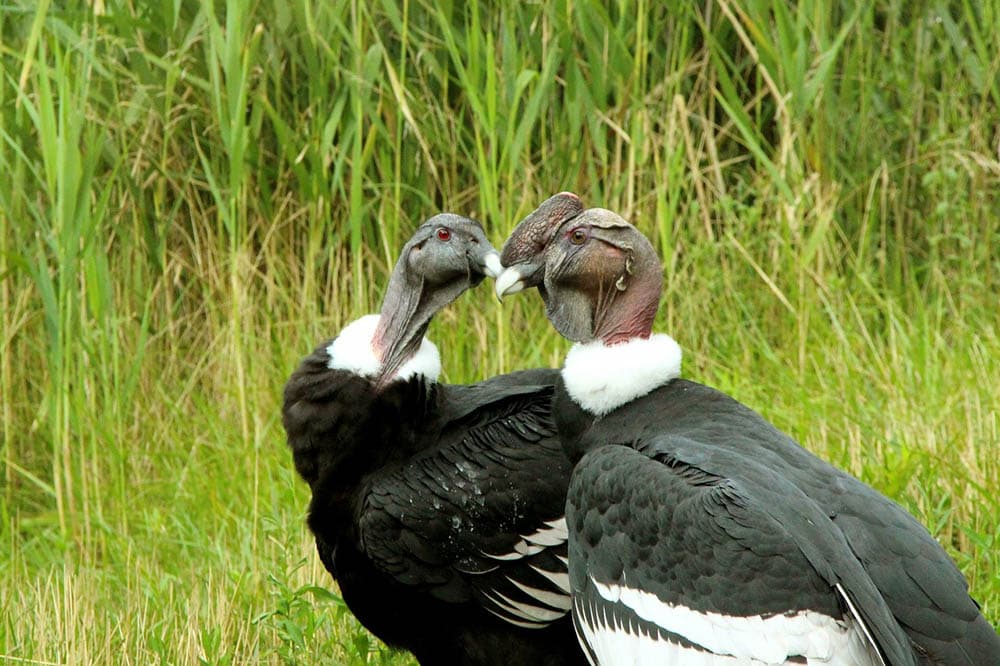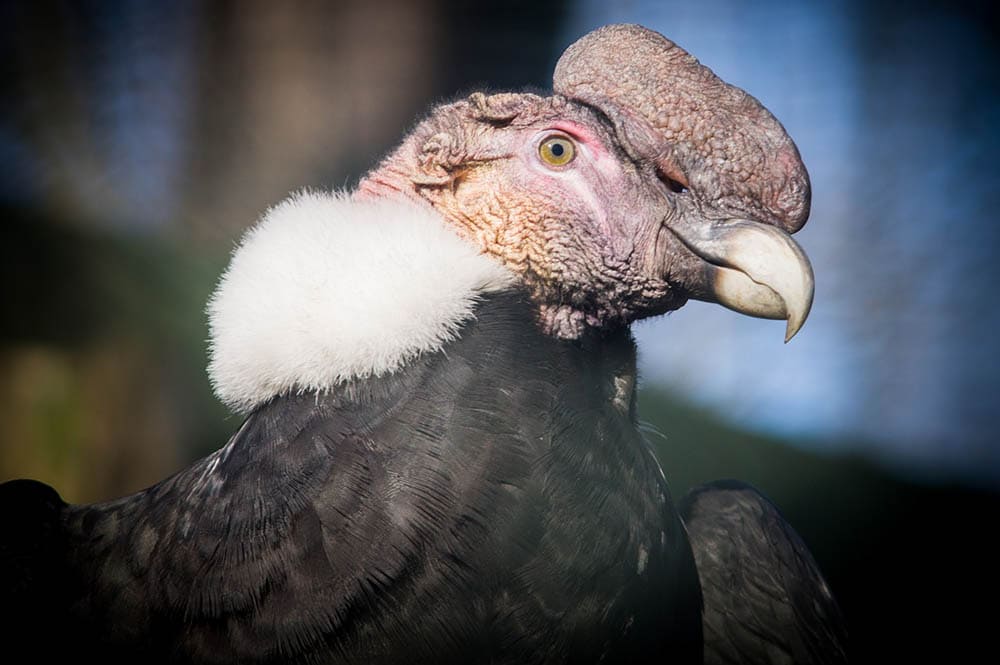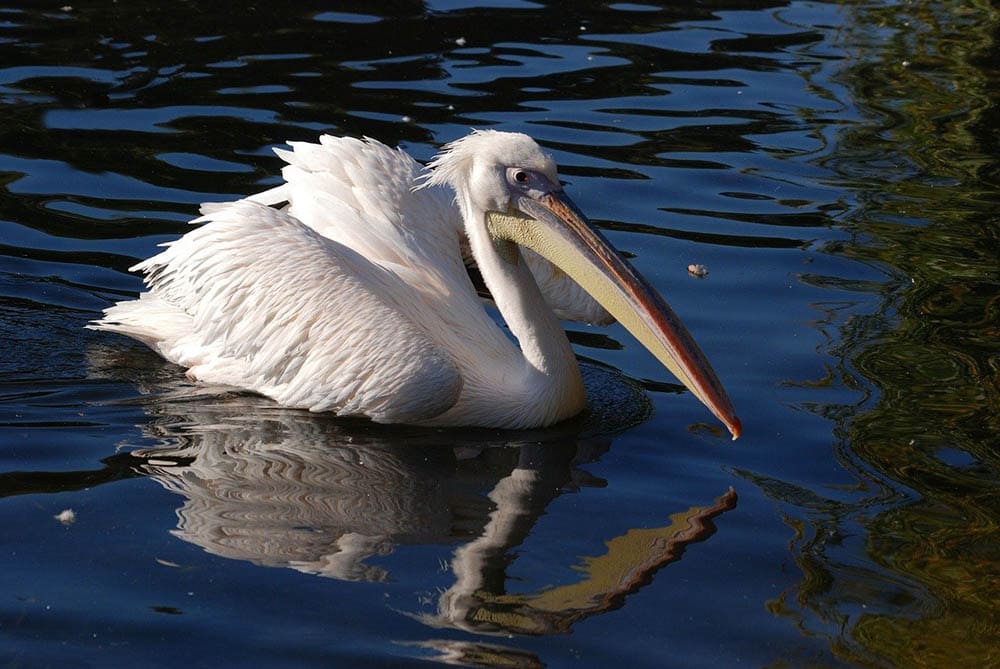Andean Condor Wingspan: How Big it Is & How it Compares to Other Birds
Last Updated on

Before the Andean Condor took that spot of being referred to as the largest flying bird on land, we had the Pelagornis Sandersi. And legend has it that this bird came with a wingspan that was so large it could comfortably stretch out from the head of a giraffe to its hoof.
If we’re being completely honest with you, we’re bummed out that we never got the chance to see just how exceptional that bird was. But then again, it’s probably for the best, considering we now get the chance to live in a world that has the Andean Condor in it.

Andean Condor

| Species Name: | Vultur gryphus |
| Population: | Approximately 6,700 |
| Conservation: | Near Threatened |
| Range: | From South America to the sea levels of Peru and Chile |
You seriously cannot mistake the Andean Condor for any other bird. Not even for its closest cousin, the California Condor. This raptor has one of the longest wingspans in the world, and just like their kinsmen, they all rock a clean baldy — Of course, this is typical of a bird with vulture-like tendencies.
We know most people know the Andean Condor is a New World vulture. What they probably don’t know is, the Andean Condor is the ONLY New World vulture that displays sexual dimorphism.
Sexual dimorphism is basically the apparent existence of observable differences between the males and females of a particular species. For example, if you look at primates, you’ll realize that the males are noticeably larger than the females.
In the case of the Andean Condor, the females lack the neck wattles and fleshy combs that the males have. Also, they often seem smaller than their male counterparts. Not too small but small enough to notice.
The Andean condor happens to be the national bird of a few South American countries. That is Ecuador, Colombia, Chile, and even Bolivia. It’s one of the many common birds of prey in those regions, as they’ve built homes in all those countries, as well as in Venezuela, Peru, Chile, and Paraguay.
If at all you’re interested in seeing one, just visit any one of those countries, and then drive to the areas that are characterized by high mountains and open grassland. Alternatively, you could go to the coastal regions or lowland deserts.

Andean Condor’s Wingspan
The Andean Condor has a wingspan that’s 10–10.5 feet long. That means it holds the record of the longest wingspan in this category, under birds currently living on land.
And that measurement applies to both the male and female Andean Condor, by the way. There’s obviously sexual dimorphism when it comes to the length of its wingspan, but even the smallest female Andean Condor has an incredibly large wingspan in comparison to most birds out there.
| Wingspan Range | Average Wingspan | |
| Male Andean Condor | 120–126 inches
304.8–320 cm |
123 inches
312.4 cm |
| Female Andean Condor | 120–124 inches
304.8–314.9cm |
122 inches
309.9 cm |
How Is Wingspan Measured?
Assuming you’re trying to determine a bird’s wingspan for whatever reason, all you have to do is measure the length from the tip of one wing, to the tip of the other. And this measurement could be only a couple of inches or more than 10 feet depending on the bird.
How you go about that measurement will also depend on whether the specimen is alive or not. You see, the method that we just described is more appropriate for a dead specimen.
If you’re using one that’s still alive and well, you’ll only have to measure the length between the center point at its back to the tip of one of its wings. And once you’ve got the measurement, multiple it by two, to get the full measurement.
We always try to avoid stretching the bird’s wings to their full extent while calculating their wingspan measurement because that could result in a fatal injury.

Andean Condor’s Wingspan Compared to Other Birds of Prey
If we had to come up with a wingspan list of all the birds in the world right now, the Andean Condor would come in fourth, as the bird with the longest wingspan. The first bird would be…
Wandering Albatross (142.7 inches)

Scientifically referred to as the Diomedea Exulans, the Wandering Albatross is currently considered the largest bird on the planet, by wingspan — Not the largest bird to ever exist, but the largest living bird. That’s pure because some of the birds that went extinct were a tad bit larger.
Its enormous wingspan is the reason why it has the ability to spend most of its life flying, only coming down to breed or feed. When they are up there in the skies, they’ll glide 95% of the time and only flap when they feel like it.
Great White Pelican (131.65 inches)

The pelican is a strange bird in the sense that its flying and swimming abilities are both incredible. The webbed toes allow it to propel itself easily and quickly while in water, and hence take flight without struggling much. It’s second on this shortlist of ours because its wingspan is longer than that of the Andean Condor but shorter than the Albatross’.
Dalmatian Pelican (127.9 inches)

These birds like spending most of their time in lakes or rivers. You’ll always find them in flocks, and when it’s time to breed, they’ll break into pairs that end up being life partners. The Dalmatian Pelican is not only one of the largest birds that we have, but also one of the heaviest. And just like their Great White cousins, they swim and fly well.
Marabou Stork (100.35 inches)

The stork is the only bird here that’s smaller than the Andean condor. They are mostly found in Africa and classified as scavengers. You’ll find them feeding on anything that looks like food, and those that don’t really look like food. Including flamingos and dead elephants.
| Wingspan Range | Average Wingspan | |
| Marabou Stork | 86.6–114.1 inches
220–290 cm |
100.35 inches
254.88 cm |
| Dalmatian Pelican | 118.1–137.7 inches
300– 350 cm |
127.9 inches
324.86 cm |
| Great White Pelican | 119.6–143.7 inches
304–365 cm |
131.65 inches
334.39 cm |
| Wandering Albatross | 141.7–143.7 inches
360–365 cm |
142.7 inches
362.45 cm |
Are All Bird Wings the Same?
The wings of different birds are normally classified into 5 groups. There’s the passive-soaring, active-soaring, elliptical, high-speed, and hovering pair. Any species that has the passive-soaring pair of wings will have the ability to soar high up, with the help of the thermals. Thermals are vertical hot air columns that rise, as the ground below heats up.
Birds that have passive-soaring wings are mostly birds of prey, such as the bald eagle, and hawk.
The active-soaring wings are also great at soaring, but they chiefly rely on wind currents. Now that we’ve thought about it, this right here is the reason why their wings are usually long and narrow. Navigating those air currents would be very difficult if they had wide or broad and short wings. The Gannets, and the Albatrosses are perfect examples of birds that come with active-soaring wings.
Elliptical wings are the type of wings found on the Sparrow, Blackbirds, or even the Crows. They are well adapted to tight maneuvering and fast takeoffs, but there’s a downside to them. You see, unlike other wings, these birds cannot maintain their top speeds for a long time.
The only birds that can take off fast and maintain that top speed for long durations are birds like the falcon — A species that has been gifted with an incredible pair of high-speed wings. The wings are very thin and moderately long. In other words, not if those of the active-soaring bird.
Our last group, which is the hovering-wing, has wings that are so quick and very tiny. And these types of wings are only found on birds that have muscles specifically suited for fast movements.
If you’ve ever spotted a Ruby-throated Hummingbird flying, you know they always look like they are levitating. That’s because their nerves and muscles allow them to move their wings at that speed.

In Conclusion
There’s something that we feel obligated to remind you, before wrapping this up. A lot of people seem to forget the fact that these birds exist in our ecosystem for a reason. And that without them, the ecosystem will no longer be in balance. So, help us spread the word, and let everybody know the Andean Condor will become extinct if we don’t stop hunting them down.
Featured Image Credit: Pixabay
Table of Contents
About the Author Robert Sparks
Robert’s obsession with all things optical started early in life, when his optician father would bring home prototypes for Robert to play with. Nowadays, Robert is dedicated to helping others find the right optics for their needs. His hobbies include astronomy, astrophysics, and model building. Originally from Newark, NJ, he resides in Santa Fe, New Mexico, where the nighttime skies are filled with glittering stars.
Related Articles:
How to Collimate Binoculars: 9 Expert Tips
Binocular Magnification Chart: Numbers & Distances Compared
How to Clean a Refractor Telescope: Step-by-Step Guide
How to Clean a Telescope Eyepiece: Step-by-Step Guide
How to Clean a Rifle Scope: 8 Expert Tips
When Were Binoculars Invented? History, Today & Future
Can You Use Binoculars to Look At Stars? How to Choose the Right Pair
How to Choose Binoculars for Bird Watching: 10 Expert Tips
